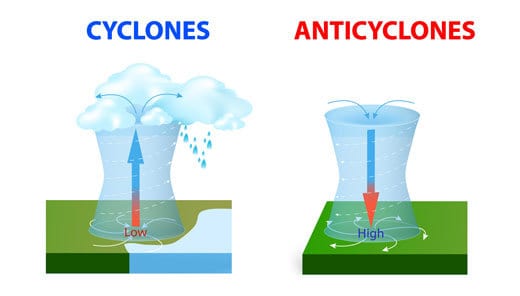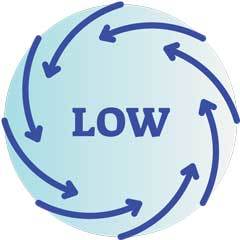Cyclones And Anticyclones: What Is The Difference?

Most readers will know or have at least heard the term "cyclone" but are unfamiliar with an event known as an anticyclone. We take a closer look at cyclones and anticyclones and their differences.
A cyclone is defined as an air mass circulating a low-pressure system, rotating counterclockwise in the Northern and clockwise in the Southern Hemisphere. An anticyclone, though, circulates a high-pressure system, rotating clockwise in the Northern and counterclockwise in the Southern Hemisphere.
This description is rather short and cryptic but will help to establish the fundamental differences between these two weather phenomena. We will discuss and define it in more detail shortly.
To better understand these two weather phenomena and how they differ, one needs to define what each occurrence is and also look at each one's characteristics.
Additionally, this post also provides a detailed table, which breaks down the primary differences between the two weather occurrences.
Cyclones Vs Anticyclones
The difference between a cyclone and an anticyclone was already summarized during the introduction, but a more elaborate explanation will help better understand how the two phenomena differ.
What Is The Difference Between A Cyclone And Anticyclone

A cyclone is a pattern of winds (or air mass) that circulates a low-pressure system. It rotates counterclockwise in the Northern Hemisphere and clockwise in the Southern Hemisphere. It is typically associated with wet and stormy weather.
An anticyclone is a pattern of winds (or air mass) that circulates a high-pressure system. It rotates clockwise in the Northern Hemisphere and counterclockwise in the Southern Hemisphere. It is typically associated with dry and fair weather.
The difference in the direction the winds rotate in the Northern and Southern Hemisphere is a direct result of the Coriolis Effect, which causes the wind to deflect to the right in the Northern Hemisphere and to the right in the Southern Hemisphere.
(Read more about the Coriolis Effect in this article.)
Why these differences between a cyclone and anticyclone occur will become more evident as one takes a closer look at the formation and characteristics of each one.
Definition And Development Of A Cyclone
As already described, a cyclone is a wind pattern circulating a low-pressure system, counterclockwise in the Northern Hemisphere & clockwise in the Southern Hemisphere.

Most cyclones (and all their variations) form over the warm waters of the Tropics. As the warm, humid air starts to rise, it leaves an area of low pressure close to the surface.
Since winds blow from a high-pressure to a low-pressure system, they rotate and diverge from the sides into this area of low pressure. This creates the familiar cloud pattern that we see with hurricanes, typhoons, and other tropical cyclones.
As the moist & humid air continues to rise, it cools down, and the water vapor can no longer stay in its gaseous form. As a result, condensation takes place, leading to cloud formation, which is usually accompanied by heavy precipitation.
Definition And Development Of An Anticyclone
As already described, an anticyclone is a wind pattern circulating a high-pressure system, clockwise in the Northern Hemisphere & counterclockwise in the Southern Hemisphere.

Sometimes, the surface over which a body of air resides starts to cool down. It may be a result of land cooling down quickly due to a lack of solar radiation or as a result of a mass of air moving in over cold ocean waters.
In turn, this cools the air down. As it cools down, the particles in the air contract and moves closer together due to a loss of energy. This causes the air to become heavier, putting more pressure on the surface below, which results in the creation of a high-pressure system.
As mentioned, winds blow from a high-pressure to a low-pressure system. In the case of an anticyclone, it blows and diverges away from the center of the high-pressure system. This results in the clear & fair weather one typically experience in the presence of an anticyclone.
Cyclone vs Anticyclone: The Key Differences
The following table highlights the key differences between a cyclone and an anticyclone.
Cyclone | Anticyclone |
|---|---|
Also known as Lows | Also known as Highs |
Circulates a low-pressure system | Circulates a high-pressure system |
Winds converge towards the center of the storm | Winds diverge away from the center of the storm |
Winds circulate counterclockwise in the Northern Hemisphere | Winds circulate clockwise in the Northern Hemisphere |
Winds circulate clockwise in the Southern Hemisphere | Winds circulate counterclockwise in the Southern Hemisphere |
Associated with wet and stormy weather conditions | Associated with dry and fair weather conditions |
Commonly occurs in the Tropics and Subtropics | Commonly occurs in the northern parts of North America and Asia |
Conclusion
As this article clearly illustrated, there are some clear differences between a cyclone and an anticyclone. Both weather phenomena are characterized by wind circulation around a pressure system, but that is where the similarities end.
In this article, we examined the primary differences between these two meteorological events. We also took a closer look at how each phenomenon develops and what its characteristics are.
Never miss out again when another interesting and helpful article is released and stay updated, while also receiving helpful tips & information by simply clicking on this link .
Until next time, keep your eye on the weather!
